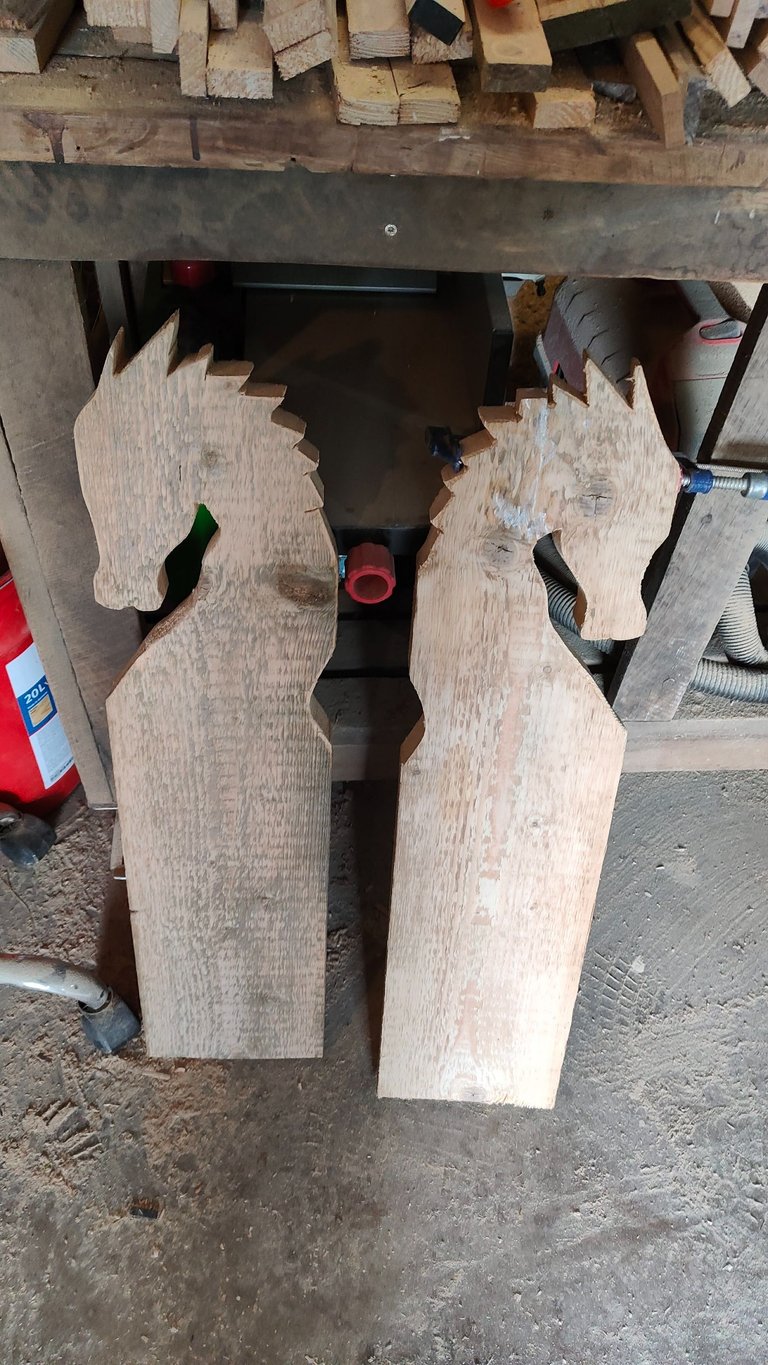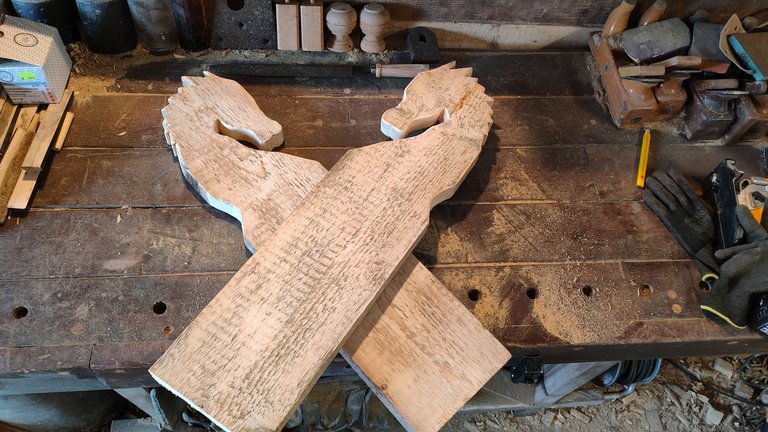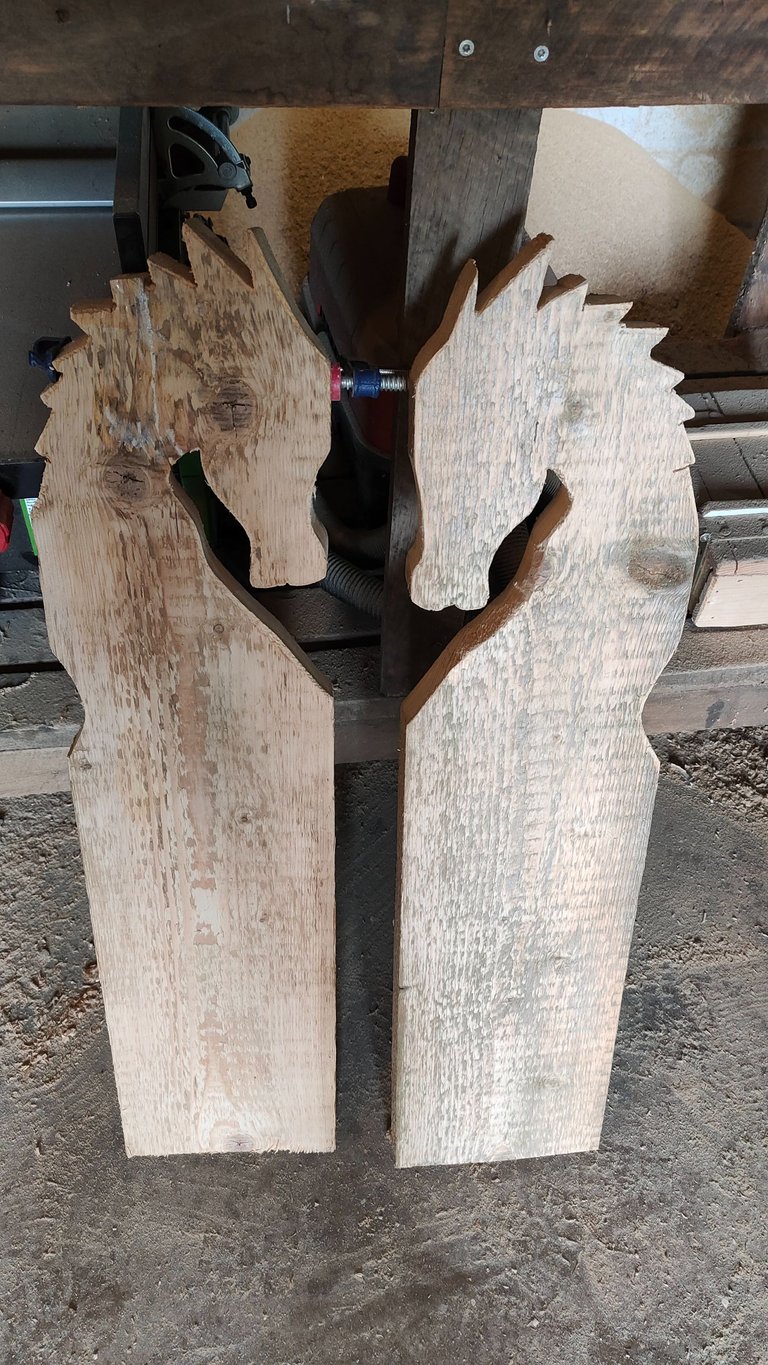
Heute habe ich zwei Pferdeköpfe nachgebaut aus einem alten Brett. Das hat richtig Spaß gemacht und ich bin mit dem Ergebnis zufrieden.
Dies ist ein typischer Giebelschmuck von alten niedersächsischen Häusern (vor allem Bauernhäuser). In Mecklenburg werden diese auch Maulaffen (Muulapen) genannt.
In Niedersachsen war und ist das Pferd das mit Abstand am häufigsten verwendete Tiersymbol. Dies ist wohl vor allem darauf zurückzuführen, dass das Sachsenross das Wappentier der welfischen Herzöge ist. Die ältere Forschung ging von einer Verwendung als Wappentier bereits in vorchristlicher Zeit aus. Heute ist diese Deutung jedoch überholt, da eine Verwendung des Pferdes als Heerzeichen bei den Altsachsen nicht zu belegen ist.
Auch die Symbolik hinter der Blickrichtung der Pferde (nach innen oder nach außen) und der Anzahl der Zügel ist unklar. Im Volksglauben sind verschiedene Deutungen verbreitet, die sich aber allesamt nicht historisch oder statistisch belegen lassen.
Die Symbolik hinter den Pferdeköpfen ist nicht klar überliefert. Der Volksglaube kennt verschiedene Deutungen, die sich aber historisch nicht schlüssig belegen lassen. Auch ist unklar, wie weit die Tradition dieses Giebelschmuckes zurückreicht. Es gibt Anzeichen, dass die Köpfe deutlich jünger sind, als es die verbreitete Deutung als heidnisch-germanisches Symbol glauben machen will. In der Heimatbewegung – insbesondere im Nationalsozialismus – wurde diese Herkunft verherrlicht und verklärt. Tatsächlich gibt es aber aufgrund des Materials und der Witterungseinflüsse an exponierter Stelle keine eindeutigen Belege für eine Verbreitung als Giebelschmuck, die wesentlich älter als 400 Jahre ist. Auf dem Teppich von Bayeux aus dem 11. Jahrhundert sind bspw. zahlreiche unterschiedliche Hauszeichen im Dachbereich dargestellt sind. Der älteste zitierte Fund beschreibt Giebelbretter mit pferdekopfähnlicher Gestaltung in der latènezeitlichen (5.–1. Jahrhundert v. Chr.) Siedlung Wallburg Altenburg im Hunsrück.
Quellen berichten, dass es in Norddeutschland noch im 16. Jahrhundert Sitte gewesen sein soll, zur Gefahrenabwehr echte Pferdeköpfe auf Stangen neben einem Haus aufzustellen. Einige Volkskundler wenden dabei ein, dass ursprünglich Abbildungen aller möglichen Arten von tierischen und menschlichen Fratzen (siehe auch: Neidkopf) zur Gefahrenabwehr an Häusern angebracht wurden. In einigen norddeutschen Gebieten habe sich die Sitte dann zunehmend auf Pferdeköpfe eingeengt.
Es wird davon ausgegangen, dass es früher auch andere Motive gab, bspw. Drachen. Und genau dies werde ich auch beim nächsten Mal ausprobieren...
Today I recreated two horse heads from an old board. That was really fun and I'm happy with the result.
This is a typical gable decoration of old Lower Saxony houses (especially farmhouses). In Mecklenburg these are also called mouth monkeys (Muulapen).
In Lower Saxony, the horse was and is by far the most frequently used animal symbol. This is probably mainly due to the fact that the Saxon horse is the heraldic animal of the Guelph dukes. The older research assumed that it was used as a heraldic animal in pre-Christian times. Today, however, this interpretation is outdated, as there is no evidence that the horse was used as a military emblem by the Old Saxons.
The symbolism behind the direction the horses are facing (inwards or outwards) and the number of reins is also unclear. Various interpretations are widespread in popular belief, but none of them can be proven historically or statistically.
The symbolism behind the horse heads is not clear. There are various interpretations in popular belief, but these cannot be conclusively proven historically. It is also unclear how far back the tradition of this gable decoration goes. There are signs that the heads are significantly younger than the popular interpretation as a pagan-Germanic symbol would have us believe. In the homeland movement - especially during National Socialism - this origin was glorified and transfigured. In fact, due to the material and the weather influences in an exposed location, there is no clear evidence of its distribution as gable decoration, which is significantly older than 400 years. On the Bayeux Tapestry from the 11th century, for example, numerous different house signs are depicted in the roof area. The oldest cited find describes gable boards with a design resembling a horse's head in the La Tène period (5th–1st century BC) settlement of Wallburg Altenburg in the Hunsrück.
Sources report that it was still the custom in northern Germany in the 16th century to place real horse heads on poles next to a house to ward off danger. Some folklorists object that images of all kinds of animal and human faces (see also: envious head) were originally attached to houses to ward off danger. In some northern German areas the custom then increasingly narrowed down to horse heads.
It is assumed that there were also other motifs in the past, such as dragons. And that's exactly what I'll try next time...



Congratulations @uniquehorn! You received a personal badge!
You can view your badges on your board and compare yourself to others in the Ranking
Check out our last posts: